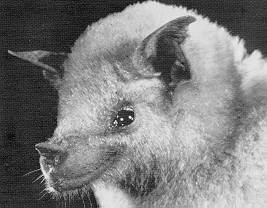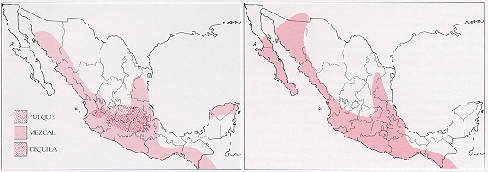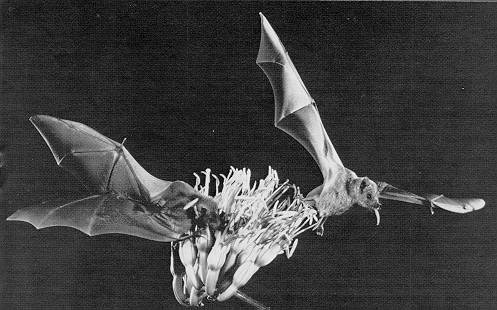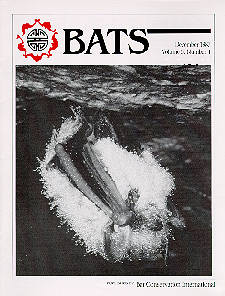
TITLE---[ Long-Nosed Bats and Agaves: The Tequila Connection ]
AUTHOR---[
Arita, Hector T., Wilson, Don E. ]
SUBTITLE---[ The interdependence between
bats and agaves is so strong that one might not be able to survive without the
other— ]
VOLUME---[ 5 ]
NUMBER---[ 4 ]
ISSUE---[ DECEMBER ]
YEAR---[ 1987 ]
START PAGE--[ 3 ]
END PAGE---[ 5 ]
AREA---[
ARTICLE ]
by Hector T. Arita and Don E. Wilson
The next time you sip a margarita or a tequila sunrise, pause for a moment to reflect on the contribution made to the tequila industry by some long unacknowledged friends: long-nosed bats. These bats (Genus Leptonycteris) are the main pollinators of Century Plants (Agave sp.), and the tequila is obtained through distillation of juices from agaves. The relationship between bats and tequila may seem obscure at first, but the bat-plant association is so strong that the disappearance of one would threaten the survival of the other. Recent surveys have shown that populations of long-nosed bats could be declining, but the possible impact on plants or the tequila industry has not been determined. The tequila connection has three main actors: the bats, the plants, and man.
Bats and agaves
Long-nosed bats are medium-sized members of the
family Phyllostomidae, weighing about one-half to one ounce (15-30 grams). As in
other nectar-feeding bats, the tongue and muzzle are elongate, an adaptation for
feeding on the nectar that accumulates in the interior of some flowers. The
short ears and the small, triangular noseleaf are signs that these bats rely
less on echolocation and probably more on their sense of smell to locate the
flowers on which they feed. The two species in this genus can be distinguished
from other North American nectar feeders by the narrow membrane between their
legs and lack of a visible tail. Sanborn's Long-nosed Bat (Leptonycteris
sanborni) lives in the dry portions of the North American tropics, from El
Salvador to northern Mexico, but in the summertime it also inhabits the
subtropical zones of Arizona and New Mexico. The Mexican Long-nosed Bat (L.
nivalis) prefers cooler, higher places, including the pine-oak woodlands and
thorn forest from Central Mexico to Texas. Both species are migratory, at least
in the northern part of their ranges.
Nectar and pollen are the main
food items for long-nosed bats. Some plants, such as the Saguaro and Organ Pipe
cacti, some species of agaves, and a variety of tropical species, open their
flowers at night and attract bats with copious amounts of nectar. As bats feast
on this sweet repast, their fur gets coated with pollen grains. When they fly to
another plant in search of more food, they transfer the pollen to a new flower,
assisting in cross-fertilization of the plants. Both the plant and the bat
benefit from this relationship, and therefore are said to be mutualists.
Scientists believe that this association is the result of the coevolution of
bats and plants and that the dependence is so strong that the plants could not
reproduce without the intervention of the bats, which would starve to death if
the plants were not present. This relationship seemingly is quite sensitive to
disturbance.
Long-nosed bats are basically cave dwellers. They have been found roosting in groups ranging from a few to several thousand individuals, but it is not uncommon to find solitary males sheltering in small crevices or tunnels. During the breeding season, females congregate in huge maternity colonies from which males are normally excluded. Available data show that long-nosed bats reproduce during the summer in the northern part of their range, but information on the populations in central Mexico is too scanty to draw any conclusions for this part of their range.
The scarcity of information on the basic biology of long-nosed bats is critical because the populations of these species seem to be declining. In Big Bend National Park, Texas, the summer population of L. nivalis is smaller than it used to be. A similar trend is occurring in Arizona, where L. sanborni no longer occupies many of the caves that formerly held colonies. In central Mexico there are still large populations of L. sanborni, but L. nivalis never was abundant and no large colonies are known. Furthermore, several caves known to house considerable numbers of these bats in the past now contain only small colonies or lack bats altogether. Considering this information, the U. S. Fish and Wildlife Service published a proposed rule in the Federal Register on July 6, 1987, to allow adding these two species to the list of Endangered Species.
Unfortunately, it is not often easy to assess the causes of vulnerability of certain species, especially for secretive animals like bats. Habitat destruction is likely the major factor affecting long-nosed bats. They are specialized nectar feeders and disappearance of their food plants could explain the decline in their populations. The fragility of the mutualistic relationships is magnified in the case of the long-nosed bats because of their migratory habits. These bats depend not only on the plants in a given region, but on a continuous supply of food along their migratory routes. Pesticides frequently are cited as a major threat to bats, but they are unlikely to seriously threaten nectar-feeding species. A possibility that has not been evaluated is that local cattlemen, in a misguided attempt to control numbers of vampire bats in Mexico, have destroyed colonies of cave-dwelling bats indiscriminately. South of the U. S. border, long-nosed bats and vampires frequently share the same caves.
The decline in populations of Leptonycteris could have terrible consequences. Many plants that depend on the long-nosed bats for their reproductive success are important components of their communities, providing food and shelter for a variety of other animals. Bees, moths, lizards, hummingbirds, woodpeckers, orioles, finches, sparrows and field mice all depend on plants pollinated by long-nosed bats, and they would be affected indirectly by reduction in bat numbers because of the concomitant decrease in plant populations. In this sense, long-nosed bats are keystone mutualists, being part of a web of ecological interactions that would be disrupted seriously by the disappearance of the bats. Furthermore, because of their migratory habits, Leptonycteris are also mobile links, connecting habitats that otherwise would lack interchange. The destruction of certain habitat in Arizona could have severe effects, through the bats, on the plant communities in Mexico. Indiscriminate killing of bats by cattlemen in Mexico potentially could affect the future of agave populations in Texas. We are facing the problem of a keystone species that moves across international borders, creating special complications that will be solved only through collaborative work of Mexican and American specialists.
Man and agaves
Man also would be affected indirectly by the
disappearance of long-nosed bats. Agaves, known in Mexico as magueyes, have been
in close association with man since the beginning of civilization in America.
Anthropologists studying the remains of ancient settlements in central Mexico,
have shown that magueyes had an important role in the diet of prehistoric
Indians. The association of agaves and man began about 10,000 years ago, the
same time as the cultivation of such important crops as corn, squash, chile
peppers and beans. These people also took advantage of the hard fibers that can
be obtained from magueyes, using them to fabricate several kinds of artifacts.
The man-agave relationship increased in importance several hundred years later when it was discovered that the juices of some magueyes (called "aguamiel" or honey water) spontaneously fermented to produce a whitish, viscous alcoholic beverage that soon became highly appreciated. The Aztec name for this beverage was "octli", and people would drink it only during important religious ceremonies. After the Spanish conquest, the name of this beverage was corrupted into "pulque", and pulque is still a popular beverage in central Mexico. The Spaniards, in addition to changing the name, introduced distillation, a technique unknown to prehispanic Indians, and provided a totally new dimension to the exploitation of agaves in Mexico. They discovered that native magueyes provided excellent raw material for the production of alcoholic beverages, and the high-proof liquor obtained from several species of agaves, especially the widely distributed A. angustifolia, came to be known as mezcal. One special kind of mezcal, produced from A. tequilana ("agave azul" or blue agave) in the region of Tequila, Jalisco, gained special attention for its quality, and soon it was known simply as tequila. Today, tequila is by far the best known Mexican liquor, and the margarita has made friends around the world.
In Mexico today, agaves are still important plants. Some species are cultivated for fibers obtained from their leaves, and the exportation of these fibers (henequin) constitutes a high percentage of the income of some regions. Mezcal and pulque are produced in cottage industries wherever appropriate agaves are found, and these products have a positive impact on the local economy in many states, particularly in Oaxaca. The rising popularity of tequila in international markets in recent years has generated an increase in production, and sales abroad represent an important contribution to the reduction of Mexico's foreign trade deficit.
Since the first prehistoric Indian discovered how to use magueyes, bats of the genus Leptonycteris have played a silent, unacknowledged role. The ancestral Mexicans did not realize that the reproduction of the indispensable magueyes depended on pollination by a secretive, nocturnal ally. Today, most of the agaves employed in the production of pulque, mezcal, and tequila are cultivated and vegetatively propagated, and the species used in the fiber industry is a hybrid that is also vegetatively propagated. However, wild populations of "maguey pulqero" (A. salmiana), as well as of A. angustifolia and A. tequilana, still exist. In fact, part of the mezcal and pulque production comes from these uncultivated stocks. These wild populations depend on the bats for their conservation, but no research has been done to demonstrate the extent of this dependence. The possible impact of the extinction of wild stocks on beverage production has not been evaluated. Wild populations are the only source of new varieties of plants propagated vegatatively, so conservation of wild agaves (and consequently of bats) should be an important issue for any industry that exploits cultivated lineages.
The future
Man has depended upon agaves for centuries, but only
recently have we realized that bats are also partners in this alliance.
Long-nosed bats are endangered by modern man's activities, and although we do
not know exactly how the extinction of these bats might affect the industries
that depend on agaves, one thing is sure: the effect will not be positive. From
this point of view, it makes clear economic sense to protect bats of the genus
Leptonycteris. Economic reasons are not, however, the only motives for
protecting an animal species. Long-nosed bats and agaves are the products of
thousands of years of coevolution and have developed special adaptations for
living together. From an ethical point of view, man has no right to terminate an
association that began several centuries before civilization. Finally, from an
aesthetic point of view, it would be disturbing indeed to destroy the delicacy
of the fragile links that connect long-nosed bats, agaves, and the diverse
assemblage of animals that find food or shelter on these plants.
The inclusion of long-nosed bats on the list of endangered species of the United States certainly would help in the battle for conservation of these bats, but similar actions need to be taken in Mexico, where more and larger populations exist. Unfortunately, little is known about the ecology of long-nosed bats in central Mexico, and the design of an adequate conservation strategy is hampered by this lack of information. Careful studies on the ecology, distribution, and movements of Leptonycteris are needed to determine the basic requirements of these animals, and a survey of the role of long-nosed bats as pollinators of wild agaves and other plants would be of primary importance. The urgency of these studies cannot be overemphasized in view of the accelerated rate of destruction of natural habitats.
(Bio)
Don E. Wilson, a member of BCI's Scientific Advisory Board, is
Chief of the U. S. Fish & Wildlife Service's Biological Survey unit located
at the National Museum of Natural History in Washington, D. C. He surveyed all
known Leptonycteris localities over a three-year period to provide status
information for the Office of Endangered Species. Hector Arita, then a student
at the Universidad Nacional Autonoma de Mexico, served as a volunteer field
associate during two of those years, and together they logged thousands of miles
throughout Mexico in search of bat colonies. Arita is now a graduate student at
the University of Florida, where he is studying the relationship between the two
species of Leptonycteris. He intends to return to Mexico to continue
ecological investigations on the bat-plant association




Photo of Cover